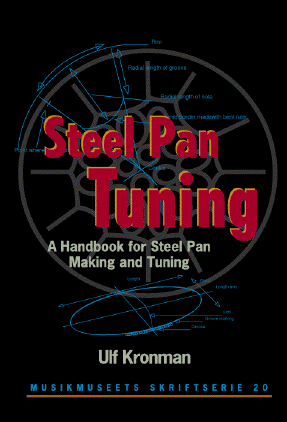

When I was sixteen, I fell in love with the sound of the steel pan, and decided that I was going to make my own. I knew they were made by hand-hammering the bottoms of surplus 55-gallon drums, and I assumed (with the brash arrogance only naive, precocious, slightly spoiled teenage boys can muster) that if it could be done by “island natives” in one of those smaller, lesser countries elsewhere in the world, it would surely be easy, for me, in my suburban backyard in Dallas, Texas, USA.
Looking back on it, now, I would just like to apologize to everyone, everywhere for that sentiment.
I did not, you rightly assume, produce a working steel pan. But not for lack of trying. I went through three 55-gallon drums, sourced from the local farm goods store and used, in their original service life, to ship tomato paste. I dragged them out into the backyard and set to, in earnest, with a four pound hammer. It was not quiet work.
The first drum was spoiled, after about five hours of pounding, by a glancing blow that tore a small crescent-shaped hole in the steel. Undaunted, I jumped in the truck and went back to the farm goods store. Before starting in on the second barrel, I took the hammer into the garage and rounded over the edges of one face with a bench grinder. In fact, I still have that hammer. Hang on, I’ll BRB…
I was able to sink the second drum about an inch further before it, too, failed. The project had now been the work of two or three days, and I was starting to get frustrated. This was 1991, you understand, when Google was not yet even a gleam in Larry or Sergei’s eye, and what information I had about the process of making steel pans came from a 1964 book by Peter Seeger called Steel Drums: How to Play Them and Make Them that’d I checked out from the local university library after a careful search of their card catalog. (Yes, there were actual cards involved.) Seeger’s book contained some good general reference material and some fascinating pictures and diagrams, and its title served to reinforce my idea that steel pan making was a fairly simple business. But it was badly out-of-date, and the title—with its in-ten-easy-steps undertone—would turn out to be seriously misleading.
Since my abortive attempts, much better information about the process has become available, and of course it turns out that making good steel pans is a very demanding trade that takes years to master. In fact, even as I was out in the backyard brutalizing everyone’s eardrums, Swedish physicist and musician Ulf Kronman was just putting the finishing touches on a book that, today, remains the seminal work on the practical aspects of steel pan manufacture. Steel Pan Tuning: A Handbook for Steel Pan Making and Tuning was first published in December 1991, based on fieldwork Kronman did in 1989 and 1990 with steel pan tuners Lawrence “Egar” Mayers and Rudy Smith.
Kronman, having been there and seen the elephant, is adamant that steel pan making is not a skill that should be learned from a book: “In fact,” he writes, “I believe it would be easier to make a working violin from just reading a handbook than to make a steel pan.” My very limited experience jives with this assessment, as does the consensus of the steel pan community: If you want to learn to make steel pans, the best way is to find somebody who already knows, and serve an apprenticeship.
On the other hand, if you don’t have access to such training (or the money it may possibly require, or the time that it certainly will), and still want to experiment with making your own steel drum (or just want to understand how it’s done) you will not find a better reference than Kronman’s book. For me, at least, it’s hard to imagine a better reference. The practical section of the book covers everything from choosing the 55-gallon drum to fine tuning the pan, finishing it, and mounting it on a stand, and the appendices are filled with meticulous measurements of real pans of many types and the original tools used to make them. A detailed theory section addresses the acoustical physics of a steel pan (which are quite complicated), and a short “Future” section, though now badly out of date, addresses some of the problems and early developments in the industrial manufacture of pans.
Best of all? It’s free. For many years after publication Steel Pan Tuning was only available in print, through respected Ohio steelpan vendor Panyard, Inc., but in 1998 Kronman released an open PDF version of the book that can still be freely downloaded at his website, today.
Technically, my own DIY steelpan project is still on hold. The third drum never broke. I even managed to sink the bottom within a half-inch of its intended depth before, at around 9:15 on a Saturday night, our next door neighbor’s patience finally snapped and he started screaming over the fence for me to for the love of god PLEASE CUT OUT THAT POUNDING.
I told you I was a bit spoiled. It had never really occurred to me that those vague shadows that sometimes moved between the fence boards would not understand and sympathize with the urgency of my steelpan project. Cowed, exhausted, and irritated, I rolled the drum back under the porch and went inside to distract myself with something else, and…well, you know how distractions can be.
ADVERTISEMENT








